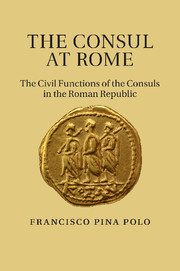Book contents
- Frontmatter
- Contents
- List of illustrations
- Acknowledgements
- Introduction
- PART I THE CONSULAR FUNCTIONS IN THE PRE-SULLAN AGE (367–81)
- 1 The consuls taking office
- 2 Consuls and civic religion
- 3 Consuls, the agents of diplomacy in the Roman state
- 4 Communication between the consuls and the people: edicts and contiones
- 5 Consuls as legislators
- 6 The jurisdiction of the consuls
- 7 Consuls as promoters of public works
- 8 Colonization and distribution of land
- 9 Appointment of a dictator
- 10 Consuls presiding over elections
- 11 The consular year in the pre-Sullan age
- PART II THE CONSULAR FUNCTIONS IN THE POST-SULLAN AGE (80–50)
- 15 Conclusion
- Bibliography
- Index of Subjects
- Index of Ancient Sources
- Index of Ancient Personal Names
9 - Appointment of a dictator
Published online by Cambridge University Press: 25 October 2011
- Frontmatter
- Contents
- List of illustrations
- Acknowledgements
- Introduction
- PART I THE CONSULAR FUNCTIONS IN THE PRE-SULLAN AGE (367–81)
- 1 The consuls taking office
- 2 Consuls and civic religion
- 3 Consuls, the agents of diplomacy in the Roman state
- 4 Communication between the consuls and the people: edicts and contiones
- 5 Consuls as legislators
- 6 The jurisdiction of the consuls
- 7 Consuls as promoters of public works
- 8 Colonization and distribution of land
- 9 Appointment of a dictator
- 10 Consuls presiding over elections
- 11 The consular year in the pre-Sullan age
- PART II THE CONSULAR FUNCTIONS IN THE POST-SULLAN AGE (80–50)
- 15 Conclusion
- Bibliography
- Index of Subjects
- Index of Ancient Sources
- Index of Ancient Personal Names
Summary
Until the end of the third century it was common to appoint a dictator as an extraordinary magistrate, either as commander-in-chief of the Roman army in the case of an emergency or to perform a specific task for a certain period of time, such as presiding over elections. The designation of a dictator was always decided by the senate, although his official appointment had to be made by a consul, who was entrusted with the task by the senators, except in exceptional circumstances. The appointment had to follow a series of traditional rules: it had to be made at night, in silence, and in a place located within the limits of Roman soil (ager Romanus).
Livy makes it clear in a few cases during the Second Punic War that the appointment of a dictator was the exclusive right of the consuls. In 217, after the defeat at Trasimene, where consul C. Flaminius died, the senate decided to appoint a dictator. The practical problem was that the living consul, Cn. Servilius Geminus, the only person who could make the appointment, was away from Rome, and the military situation made it very difficult to contact him in order to demand his return. Due to this, Livy says, for the first time in the history of Rome the people elected a dictator by voting in comitia.
- Type
- Chapter
- Information
- The Consul at RomeThe Civil Functions of the Consuls in the Roman Republic, pp. 188 - 191Publisher: Cambridge University PressPrint publication year: 2011



